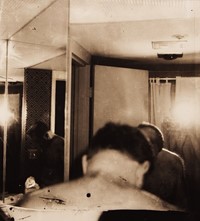Featuring the likes of David Wojnarowicz, Mark Morrisroe and Larry Clark, new exhibition Rough Trade: Art and Sex Work in the Late 20th Century shines a light on a fascinating side of art history
- TextMiss Rosen
In the years between the sexual revolution, Stonewall, and the advent of AIDS, the repressive respectability politics of the 1950s fell away, allowing a generation of men and women to come of age expressing their sexuality with more freedom than ever before. As social attitudes relaxed, many artists explored massage parlours, go-go bars, pornographic theaters, and strip clubs – the spaces where sex work flourished.
Greg Ellis of Ward 5B and Brian Clamp have co-curated Rough Trade: Art and Sex Work in the Late 20th Century, a new group exhibition currently on view at ClampArt, New York, until September 22, 2018. Organised to coincide with David Wojnarowicz: History Keeps Me Awake at Night, this exhibition takes a look at the relationship between artists and sex workers.
Some, like Wojnarowicz and Mark Morrisroe, drew upon their traumatic early histories as hustlers, while others like Larry Clark and Tomata du Plenty documented their friends, lovers, and acquaintances involved in the sex industry. Rough Trade also includes works by John Barrington, Kenny Burgess, Philip-Lorca diCorcia, Fred Halsted, John Sex, Jane Sherry, Pedro Slim, Samuel Steward, and Tommy Vallette, as well as related ephemera. Speaking to Another Man, Ellis shares his insights on this fascinating side of art history.
“I realised that a number of artists like David Wojnarowicz and Mark Morrisroe had histories of sex work themselves. It was a world so many people in the queer community came from. I was involved in harm reduction in the 80s, and a lot of the work we did was in peep shows and adult theatres, so I got to know a lot of the folks who worked in there. One of my dear friends was Richard Berkowitz, who wrote How to Have Sex in an Epidemic, and he was an S&M sex worker as well. He helped me understand what those influences are in a person’s life that brings them to that place.
“When I say sex work, we are using a broader spectrum. It’s not just prostitution but people who are strippers, adult entertainers or making pornographic images – like Peter Hujar who had his own line of adult male greeting cards. So many of the artists of the period were left out of the art world at the time, so they created their own spaces, like the Times Square Show (1980) which took place in an abandoned massage parlour.
“We have a lot of ephemera in the show directly related to different archives of various hustlers. You can see how media has changed. In the past, you had to answer an ad in the back of a magazine and wait for a response in the mail before you could actually make that contact. Often times, it was a relationship that developed over years and decades, like Mark Morrisroe documented in some of the photographs.
“It’s a rich subject, and I think it goes back to the queer influence. We were coming out of an era that was extremely conservative and homogenous. We were focussed on experiences and out getting them. You literally had to go out on the streets to find it. Pornography used to be in a secluded place you had to go to, whether it was on the outskirts of town or in Times Square where there was this red mile of businesses. There was an excitement, because it was new for so many people who were young and in sexual minorities, who were moving to cities. I realised it was always there and it was part of the world I personally came from.”
Rough Trade: Art and Sex Work in the Late 20th Century is at ClampArt, New York, until September 22, 2018















